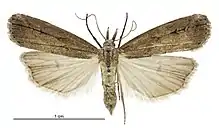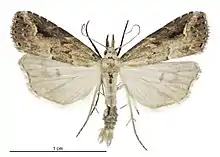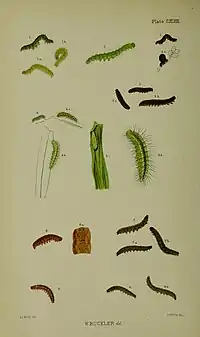Schrankia costaestrigalis
Schrankia costaestrigalis, the pinion-streaked snout, is a species of moth of the family Erebidae. It is found in Europe, the Canaries, Madeira, Syria, Armenia. It is also present in New Zealand. The species closely resembles Crambidae or Pyralidae species.
| Pinion-streaked snout | |
|---|---|
 | |
| Female | |
 | |
| Male | |
| Scientific classification | |
| Domain: | Eukaryota |
| Kingdom: | Animalia |
| Phylum: | Arthropoda |
| Class: | Insecta |
| Order: | Lepidoptera |
| Superfamily: | Noctuoidea |
| Family: | Erebidae |
| Genus: | Schrankia |
| Species: | S. costaestrigalis |
| Binomial name | |
| Schrankia costaestrigalis (Stephens, 1834) | |
| Synonyms | |
| |
Technical description and variation
The wingspan is 16–22 mm. The length of the forewings is 9–11 mm. Forewing whitish ochreous, mixed with brownish fuscous towards costa; a fine black dash beneath costa at base; inner line partly blackish, dentate; outer oblique, irregular, partly marked with dark and edged posteriorly with whitish; cellspot small, blackish, connected with outer line by dark fuscous suffusion; subterminal line indistinct, pale; hindwing luteous whitish, with a grey discal dot.[1]

.jpg.webp)
Biology
The moth flies from May to October depending on the location.
Larva dark purplish brown; dorsal and subdorsal lines pale, the latter black-edged beneath; sides more ochreous; will feed on flowers of thyme in captivity. The larvae feed on various herbaceous and woody plants. Reported to feed on potato tubers and to cause significant crop loss (>80%) in China.[2]
References
- Seitz, A. Ed., 1914 Die Großschmetterlinge der Erde, Verlag Alfred Kernen, Stuttgart Band 3: Abt. 1, Die Großschmetterlinge des palaearktischen Faunengebietes, Die palaearktischen eulenartigen Nachtfalter, 1914
- Zeng, Xianru; Yu, Yonghao; Gao, Xuyuan; Long, Xiuzhen; Jiang, Xiaodong; Liu, Jimin; Wei, Dewei; Gao, Yulin; Zhou, Zhongshi (2020-03-01). "First record of a damage to potato caused by Schrankia costaestrigalis (Stephens, 1834), a new potential pest in China". Journal of Pest Science. 93 (2): 555–558. doi:10.1007/s10340-020-01195-w. ISSN 1612-4766.